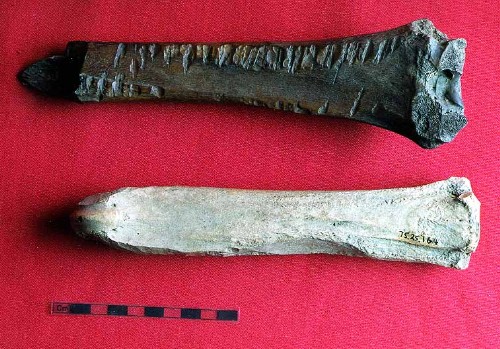|
|
Two Ice-Skates from Oxford: 9th century and 12th century |

We know from other sources that winters in Britain were colder than normal in the 12th century and perhaps for several centuries previously. Rivers froze, and Oxford’s citizens took to the river on ice-skates home-made from recycled animal long-bones trimmed to a flat surface on one side, and a hollow surface on the other. To hold the skates on over shoes, the ends of the bone skates were double-pierced for the insertion of a leather thong.
Both skates from Oxford are made from horse long-bones. The darker skate, from a radius bone, comes from 9th-century levels in St Aldates near the Thames crossing, and was worn smooth from use. The lighter skate, from a metacarpal bone, was never finished; it came from 12th-century levels in St Ebbes in central Oxford.
The use of bone skates in late 12th-century London is described as follows by a contemporary observer:
‘Dense throngs of youths go forth to disport themselves upon the ice...(the more skilled) fit to their feet the shin-bones of beasts lashing them beneath their ankles, and with iron-shod poles in their hands they strike ever and anon against the ice and are borne along swift as a bird in flight or a bolt shot from a mangonel.’
(A "mangonel" was a military engine for casting stones.)
© 1998 Oxfordshire Museum Service, Setúbal Museums and the Benaki Museum